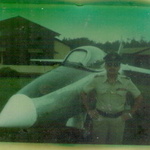The Folland Gnat did Yeoman Service for IAF

The Indian Air Force has a checkered history and many types of planes have been part of its arsenal. Earlier the planes used by the IAF were of British origin as the IAF had been created by an act of the British parliament in 1932. It had a strong association with the British Royal Air Force and during the days of the Raj, many vintage fighters were transferred to the IAF. After 1947 this trend continued as the first 2 Chiefs of the Air Force were British.
During this period a committee appointed by the government after evaluation decided that the Folland Gnat was a good interceptor for the IAF. The Gnat was a midget fighter bomber with a max speed of 0.98 Mach. It could carry 2 500 Lb bombs and also had machine guns. It was a single seater fighter bomber and due to its small size was a difficult target for the enemy planes. My father used to fly this plane and he opined that it was a very swift and maneuverable fighter.
The Gnat remained in service for about 15 years before it was phased out. In fact it was the last British fighter to join the IAF as after some time the British began to play dirty and stopped supply of essential parts and ammunition for the plane. India then turned to the Russians and the MIG's made an entry into the IAF.
The Gnat was a very successful interceptor and earned the nick name " Sabre killer". In the 1965 war the Gnat shot many Pakistan Air Force Sabre jets in single combat. Very few Gnats by comparison were lost in aerial combat. Partly this was also because of the skill of the IAF pilots who flew dare devil missions against the PAF.
The last Gnat flew for the IAF in 1968 and a plane is kept in the Air Force museum at Palam in Delhi. Readers who visit Delhi, must visit the museum located in Delhi Cantt at Palam. It is worth a visit.
Photo of Gnat along with me by a friend.
Like it on Facebook, Tweet it or share this article on other bookmarking websites.
